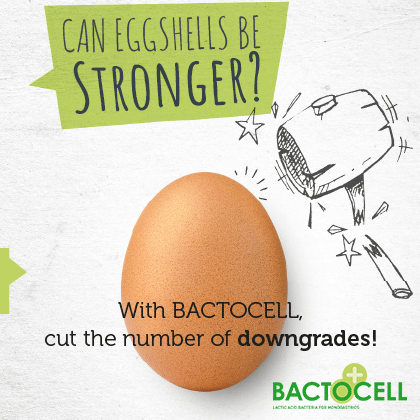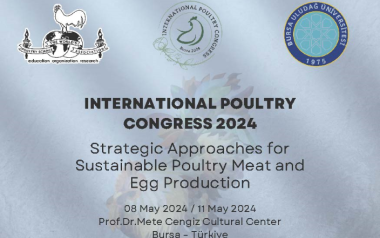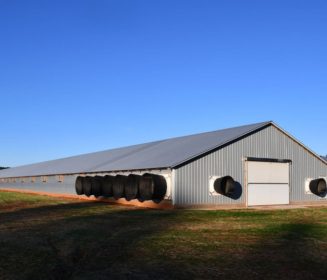ESPN 2023: NUTRITIONAL AND FEEDING STRATEGIES FOR ANTIBIOTIC-FREE POULTRY PRODUCTION
Edgar Orlando Oviedo-Rondón, the director of the avinews Internacional technical magazine was present at ESPN 2023 showing his presentation on nutritional and feeding strategies for antibiotic-free poultry production.
Edgar Orlando Oviedo-Rondón, the director of the avinews International technical magazine was present at ESPN 2023 showing his presentation on nutritional and feeding strategies for antibiotic-free in poultry production.
INTRODUCTION
Antibiotic-free (ABF) poultry production has multiplied worldwide. The motives are different in each country or region. They can vary between governmental regulations as a precaution for antimicrobial resistance, local consumer pressure, or the exportation of poultry products to countries with regulations for foodstuffs free of antibiotics or its metabolites. In some areas of the world, ABF is still difficult to accept for some poultry producers, technical personnel, and farmers. But some poultry companies in many countries voluntarily decided to produce without antibiotic growth-promotors (AGPs) two decades ago. Several producers can already claim successful ABF production. However, reaching productivity, health, livability, food safety, and environmental impacts similar to conventional systems with AGPs is still a challenge for many. Data from AgriStats (the largest benchmarking company in the USA) indicates a clear gap in productivity aspects between ABF programs and traditional production systems.
On the other hand, it is also important to remember that AGPs have not always been effective in preventing diseases, even when applying high dosage rates of AGPs and ionophores or adding combinations of multiple products. In some farms, gut and respiratory health issues are frequent independently of using AGPs, ionophores, chemical coccidiostats, or alternative feed additives. The evidence indicates that the feed additive per se is not the solution to some potential performance and health issues primarily related to feed and water quality, housing infrastructure, environmental stress, and management. Bacterial and mycoplasma resistance to certain antibiotics (Nhung et al., 2017) and Eimeria resistance to some coccidiostats (Chapman and Rathinam, 2022) were already evident in many areas of the world decades before ABF became popular. Consequently, transitioning to ABF systems could also be considered an alternative to more sustainable and efficient production for those who have not yet done so.
There are several categories of ABF production around the world. A standard label Certification used by many poultry producers worldwide is raised without antibiotics (RWA) because birds may receive antibiotics in ovo or at hatch with vaccines. In the USA, ionophore coccidiostats are classified as AGP, and consequently, not even those ionophore products are used as feed additives in some of these ABF programs.
The American industry has voluntarily chosen to grow more than half of the broilers in systems targeting the requirements of the “No-Antibiotics-Ever” (NAE) label description regulated by the US Department of Agriculture (USDA). Nevertheless, when diseases happen, and birds need to be treated, these flocks are not sold with this label. The NAE production is more challenging to maintain, and total production costs are higher than ABF. However, these NAE systems keep growing in the USA (Figure 1) in the total number of chickens produced (Rennier Associates Inc., 2022; AgriStats, 2023). However, there is some seasonality in the number of flocks that finish in this NAE program.
ACHIEVING SUSTAINABLE ABF PRODUCTION
Changing to ABF programs depend on a decision related to the withdrawal of feed additives. But it is already proven by experience in many companies that maintaining similar productivity, poultry health and welfare, and food safety requires multiple interventions in the production system (Smith, 2011, 2019). This presentation is focused on nutritional and feeding strategies.
However, the first take-home message is that, independently of all improvements we can make in nutrition, feed manufacturing, and feeding, they will not be enough to achieve optimal ABF production. Breeder intestinal health and enhanced maternal immunity, optimum incubation practices, improved housing infrastructure, proper ventilation, optimum house environmental control, management, frequent disposition of mortality, biosecurity, effective vaccination programs, and water quality are also fundamental to achieving sustainable ABF systems.

Figure 1A Distribution of the US broiler industry according to marketing program with either full use of all antibiotic growth-promoters (AGPs), reduced use, use of only ionophores or NonAntibiotics Ever (NAE), (Source: Rennier Associates Inc., May 2022). B. Percentage of the US broiler industry production raising under NAE programs (Source: AgriStats Inc. 6510 Mutual Dr, Fort Wayne, IN 46825).
The reduction in AGP use is easy to obtain by withdrawing or restricting the use of specific products. Still, many times fails to minimize the use of molecules that could increase multi-antimicrobial resistance. For example, Nunan (2022) reported that in the United Kingdom, the British Poultry Council reported that the use of medically-important antibiotics reduced by 85% between 2013 and 2017 from 94 tons to 14 tons.
In contrast, the use of ionophores increased from 209 tons to 281 tons in the same period, causing the overall antibiotic use to barely change in the same period. Higher use of ionophores in the UK (265 tons in 2019) is related to a higher incidence of gut health problems, necrotic enteritis, and coccidiosis. The lack of AGPs did not cause these issues.
They are due to prevalent feed, housing, biosecurity, and litter management problems that should be controlled with other strategies (Smith, 2011, 2019; Cervantes and McDougald, 2023) It is observed worldwide that despite having the best housing infrastructure and management practices, there is a seasonality in poultry health issues and productivity. The seasonal effect could depend on the weather but may be related to higher stocking density forced by market conditions or chicks of lower quality from eggs stored for a long time.
In the USA, AgriStats reports indicate that between January and March, flock livability decreases. The calorie conversion to meat worsens, and the days to reach the target weight for processing increase in the same period. The seasonality is similar in traditional, ABF, or NAE programs, but the harmful effects are generally worst in NAE flocks. This data and observations worldwide provide clear evidence that nutrition and feeding cannot always mitigate these problems. But, nutritional and feeding strategies should consider seasonalities.
On the other hand, water, the most essential nutrient, can modify the animal response to any diet. The nutritionist should keep in mind the effects of water availability, temperature, physicochemical properties, and microbiological quality. In specific farms and regions, water factors could be the leading cause of eventual gut health issues, and no feed intervention can solve them completely. Adding probiotics, prebiotics, essential oils, organic acids, electrolytes, minerals like copper sulfate, and vitamins to the water lines for several days may cause clogging, increased algae and bacteria, and damage water equipment. These products should be included in the feed.
NUTRITIONAL AND FEEDING STRATEGIES
Poultry flocks raised in ABF programs have potentially more microbial and immunological challenges, dysbiosis, and mucosal inflammation. The protein turnover and energy needs are potentially higher. Therefore, from the nutritional standpoint, it is vital to enhance gizzard and intestinal development early in life, stimulate an early development of a healthy gut microbiome, and minimize contamination and development of pathogenic bacteria and protozoa. The following are critical nutritional and feeding points to consider in ABF production.
Feed formulation
- Design a feeding program with more dietary phases but avoiding changes near the peaks of coccidia infection or age periods with the most common management stress or dysbiosis events.
- Select ingredients with higher digestibility, a lower potential to increase gut viscosity, and minor risks of Clostridial or Salmonella contamination, especially in the pre-starter and starter diets. This generally means lower inclusion of animal-origin feedstuffs and more vegetarian diets.
- Avoid protein excess, but guarantee optimum levels of essential amino acids by using more crystalline sources.
- Include descriptive fiber parameters like ADF, insoluble, and soluble fiber in the feed formulation matrix. Implement a minimum level of ADF or insoluble dietary fiber (minimum of 2% and maximum of 3%) and a maximum of soluble fiber (no more than 20 to 30% of total dietary fiber). The ADF/NDF ratio in the feed should be kept at a minimum of 0.37 to achieve optimum gut development, nutrient digestibility, and performance (Nursiam et al., 2022).
- Account for all calcium sources in the diet and limit its inclusion to requirement levels.
- Keep a dietary electrolyte balance (Na+K – Cl) between 200 and 250 mEq/kg and adjust depending on water mineral content.
Feedstuff quality
- Improve description of feedstuff energy values, nutrient digestibility, and nutrient and antinutrient contents using rapid methods like the NIRS calibration models available and identify its variability.
- Control fungi and mycotoxin contamination and insect infestation in the whole system.
- If possible, use fat sources with better digestibility rich in medium-chain fatty acids (lauric, caprylic, and capric) like palm kernel oil, coconut oil, or even insect oil.
- Avoid rancidity in all ingredients rich in fatty acids (peroxide values ideally max. 5-10 mEq O2 / kg, TBARS 2-3 mg MDA/kg, and p-Anisidine value below 5).
- Limit the inclusion of soybean sources with trypsin inhibitor levels higher than 4.5 mg/g, and avoid overprocessed soy products.
- Select or request soybean meal with a geometric mean particle size (dgw ) of a minimum of 900 mm (minimize particles lower than 250 mm or higher than 1,700 mm)
- Choose trace minerals with higher bioavailability. Organic Zn, Cu, and Mn bring health benefits.
Feed additive selection
- Seed the gut with probiotics and prebiotics, including these products in pre-starter and starter diets.
- Include exogenous enzymes according to substrate concentration to improve digestibility or minimize antinutrient effects. All diets may benefit from phytase at higher levels and xylanase.
- Use additives to modulate gut microbiota and have anti-inflammatory properties like plant extracts, essential oils, polyphenols, and higher levels of vitamins A, E, D, and C, especially in the seasons with a higher incidence of health outbreaks.
- Provide gut mucosa integrity with butyric acid, mycotoxin binders, or detoxifiers.
- Emulsifiers, lipotropic, and bile salts may play a role in protecting liver function.
- Establish an effective coccidia control program according to the ABF program selected (Smith, 2019; Cervantes and McDougald, 2023).
Feed manufacturing
- Grind ingredients coarse targeting a minimum dgw of 700 mm for starter diets, 850 mm for grower diets, 1,000 for finisher diets, and at least 1,250 for breeders and layers. But, minimize variability (Sgw ) in particle distribution and particles smaller than 250 mm for broilers and 500 mm for hens.
- Try the inclusion of whole grains. Positive results have been observed, including between 5 to 15% whole wheat (Sadati et al., 2022) and 2.5 to 5% whole corn (Ovi et al., 2021) in pelleted diets.
- Use physical or chemical methods to decrease bacterial load in feed (Huss et al., 2018).
- Avoid pelleting temperatures higher than 90oC to minimize deleterious Maillard reactions.
Feeding practices
- Try to increase feeding phases to meet nutrient needs closely and avoid nutrient intake excess.
- Maximize feed intake during the first hours post-placement using additional lights or higher intensity near feeders, paper on the floor, and supplemental feeders.
- Consider using control feeding programs or intermittent lighting programs to slow down feed intake and improve crop retention time and foregut digestion.
- Control house feed inventories to avoid periods of feed withdrawal.
Missing knowledge The nutritional concepts needed to improve poultry nutrition in general but essential to improve ABF production are 1) the kinetics of starch and protein digestibility; values of rapid and slow starch digestion, resistant starch, damaged starch, and amylose-to-amylopectin ratios to apply them in feed formulation; 2) Optimum values of starch and fiber parameters; 3) Net energy values for each feed ingredient and feeding phase; 4) Digestible calcium values; 5) More accurate NIRS curves to predict digestibility and energy values; and 6) True protein for feed formulation.
CONCLUSIONS
The nutritional and feeding strategies can be planned to address the challenges observed in ABF and NAE production. However, breeder, hatchery, infrastructure, and husbandry interventions are necessary. Diet formulation, feedstuff quality, additive selection, and feed manufacturing should be targeted to maximize gizzard and intestinal development, stimulate a healthy microbiome, minimize contamination and infection, and maintain gut physiology. Feeding practices can aid in minimizing issues of early feed intake and fast feed intake later on.
REFERENCES UNDER CONSULTATION OF THE AUTHOR





































